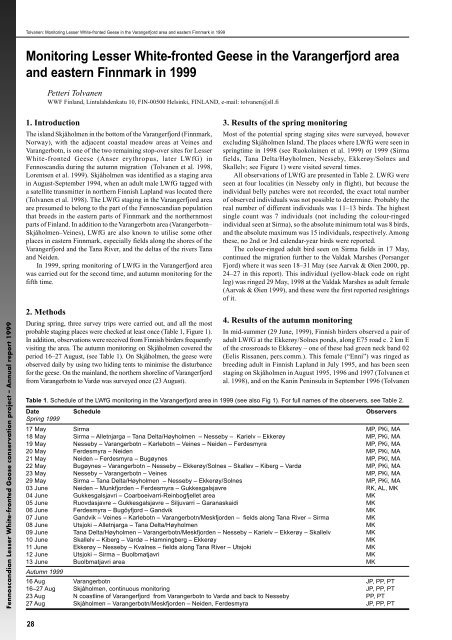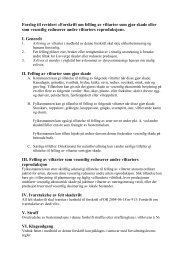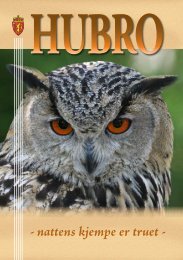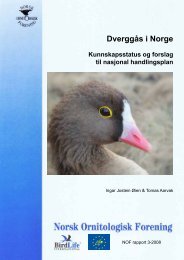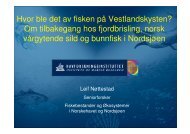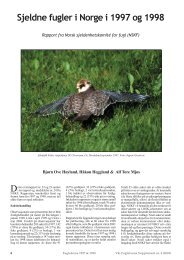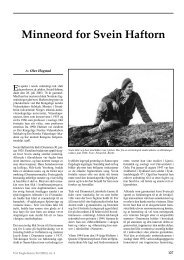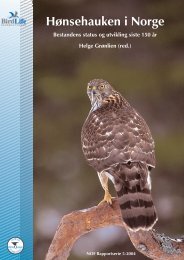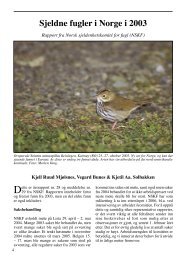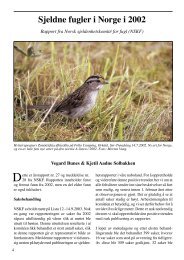Fennoscandian Lesser White-fronted Goose conservation project ...
Fennoscandian Lesser White-fronted Goose conservation project ...
Fennoscandian Lesser White-fronted Goose conservation project ...
Create successful ePaper yourself
Turn your PDF publications into a flip-book with our unique Google optimized e-Paper software.
<strong>Fennoscandian</strong> <strong>Lesser</strong> <strong>White</strong>-<strong>fronted</strong> <strong>Goose</strong> <strong>conservation</strong> <strong>project</strong> – Annual report 1999<br />
Tolvanen: Monitoring <strong>Lesser</strong> <strong>White</strong>-<strong>fronted</strong> Geese in the Varangerfjord area and eastern Finnmark in 1999<br />
Monitoring <strong>Lesser</strong> <strong>White</strong>-<strong>fronted</strong> Geese in the Varangerfjord area<br />
and eastern Finnmark in 1999<br />
1. Introduction<br />
The island Skjåholmen in the bottom of the Varangerfjord (Finnmark,<br />
Norway), with the adjacent coastal meadow areas at Veines and<br />
Varangerbotn, is one of the two remaining stop-over sites for <strong>Lesser</strong><br />
<strong>White</strong>-<strong>fronted</strong> Geese (Anser erythropus, later LWfG) in<br />
Fennoscandia during the autumn migration (Tolvanen et al. 1998,<br />
Lorentsen et al. 1999). Skjåholmen was identified as a staging area<br />
in August-September 1994, when an adult male LWfG tagged with<br />
a satellite transmitter in northern Finnish Lapland was located there<br />
(Tolvanen et al. 1998). The LWfG staging in the Varangerfjord area<br />
are presumed to belong to the part of the <strong>Fennoscandian</strong> population<br />
that breeds in the eastern parts of Finnmark and the northernmost<br />
parts of Finland. In addition to the Varangerbotn area (Varangerbotn–<br />
Skjåholmen–Veines), LWfG are also known to utilise some other<br />
places in eastern Finnmark, especially fields along the shores of the<br />
Varangerfjord and the Tana River, and the deltas of the rivers Tana<br />
and Neiden.<br />
In 1999, spring monitoring of LWfG in the Varangerfjord area<br />
was carried out for the second time, and autumn monitoring for the<br />
fifth time.<br />
2. Methods<br />
During spring, three survey trips were carried out, and all the most<br />
probable staging places were checked at least once (Table 1, Figure 1).<br />
In addition, observations were received from Finnish birders frequently<br />
visiting the area. The autumn monitoring on Skjåholmen covered the<br />
period 16–27 August, (see Table 1). On Skjåholmen, the geese were<br />
observed daily by using two hiding tents to minimise the disturbance<br />
for the geese. On the mainland, the northern shoreline of Varangerfjord<br />
from Varangerbotn to Vardø was surveyed once (23 August).<br />
28<br />
Petteri Tolvanen<br />
WWF Finland, Lintulahdenkatu 10, FIN-00500 Helsinki, FINLAND, e-mail: tolvanen@sll.fi<br />
3. Results of the spring monitoring<br />
Most of the potential spring staging sites were surveyed, however<br />
excluding Skjåholmen Island. The places where LWfG were seen in<br />
springtime in 1998 (see Ruokolainen et al. 1999) or 1999 (Sirma<br />
fields, Tana Delta/Høyholmen, Nesseby, Ekkerøy/Solnes and<br />
Skallelv; see Figure 1) were visited several times.<br />
All observations of LWfG are presented in Table 2. LWfG were<br />
seen at four localities (in Nesseby only in flight), but because the<br />
individual belly patches were not recorded, the exact total number<br />
of observed individuals was not possible to determine. Probably the<br />
real number of different individuals was 11–13 birds. The highest<br />
single count was 7 individuals (not including the colour-ringed<br />
individual seen at Sirma), so the absolute minimum total was 8 birds,<br />
and the absolute maximum was 15 individuals, respectively. Among<br />
these, no 2nd or 3rd calendar-year birds were reported.<br />
The colour-ringed adult bird seen on Sirma fields in 17 May,<br />
continued the migration further to the Valdak Marshes (Porsanger<br />
Fjord) where it was seen 18–31 May (see Aarvak & Øien 2000, pp.<br />
24–27 in this report). This individual (yellow-black code on right<br />
leg) was ringed 29 May, 1998 at the Valdak Marshes as adult female<br />
(Aarvak & Øien 1999), and these were the first reported resightings<br />
of it.<br />
4. Results of the autumn monitoring<br />
In mid-summer (29 June, 1999), Finnish birders observed a pair of<br />
adult LWfG at the Ekkerøy/Solnes ponds, along E75 road c. 2 km E<br />
of the crossroads to Ekkerøy – one of these had green neck band 02<br />
(Eelis Rissanen, pers.comm.). This female (“Enni”) was ringed as<br />
breeding adult in Finnish Lapland in July 1995, and has been seen<br />
staging on Skjåholmen in August 1995, 1996 and 1997 (Tolvanen et<br />
al. 1998), and on the Kanin Peninsula in September 1996 (Tolvanen<br />
Table 1. Schedule of the LWfG monitoring in the Varangerfjord area in 1999 (see also Fig 1). For full names of the observers, see Table 2.<br />
Date Schedule Observers<br />
Spring 1999<br />
17 May Sirma MP, PKi, MA<br />
18 May Sirma – Alletnjarga – Tana Delta/Høyholmen – Nesseby – Karielv – Ekkerøy MP, PKi, MA<br />
19 May Nesseby – Varangerbotn – Karlebotn – Veines – Neiden – Ferdesmyra MP, PKi, MA<br />
20 May Ferdesmyra – Neiden MP, PKi, MA<br />
21 May Neiden – Ferdesmyra – Bugøynes MP, PKi, MA<br />
22 May Bugøynes – Varangerbotn – Nesseby – Ekkerøy/Solnes – Skallev – Kiberg – Vardø MP, PKi, MA<br />
23 May Nesseby – Varangerbotn – Veines MP, PKi, MA<br />
29 May Sirma – Tana Delta/Høyholmen – Nesseby – Ekkerøy/Solnes MP, PKi, MA<br />
03 June Neiden – Munkfjorden – Ferdesmyra – Gukkesgalsjavre RK, AL, MK<br />
04 June Gukkesgalsjavri – Coarboeivarri-Reinbogfjellet area MK<br />
05 June Ruovdasjavre – Gukkesgalsjavre – Siljuvarri – Garanaskaidi MK<br />
06 June Ferdesmyra – Bugöyfjord – Gandvik MK<br />
07 June Gandvik – Veines – Karlebotn – Varangerbotn/Meskfjorden – fields along Tana River – Sirma MK<br />
08 June Utsjoki – Alletnjarga – Tana Delta/Høyholmen MK<br />
09 June Tana Delta/Høyholmen – Varangerbotn/Meskfjorden – Nesseby – Karielv – Ekkerøy – Skallelv MK<br />
10 June Skallelv – Kiberg – Vardø – Hamningberg – Ekkerøy MK<br />
11 June Ekkerøy – Nesseby – Kvalnes – fields along Tana River – Utsjoki MK<br />
12 June Utsjoki – Sirma – Buolbmatjavri MK<br />
13 June Buolbmatjavri area MK<br />
Autumn 1999<br />
16 Aug Varangerbotn JP, PP, PT<br />
16–27 Aug Skjåholmen, continuous monitoring JP, PP, PT<br />
23 Aug N coastline of Varangerfjord from Varangerbotn to Vardø and back to Nesseby PP, PT<br />
27 Aug Skjåholmen – Varangerbotn/Meskfjorden – Neiden, Ferdesmyra JP, PP, PT


